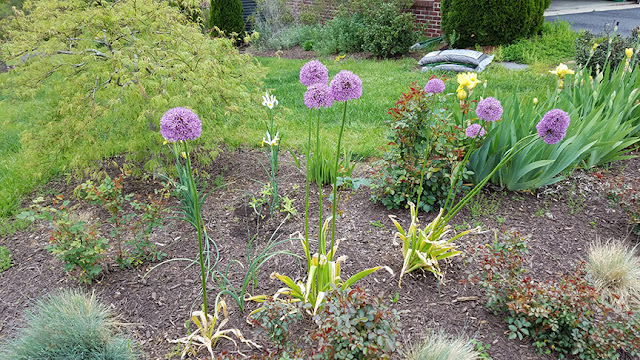 |
| The back yard in April. |
As the garden resurrects with much-awaited April showers, the seasonal sequence of flowers continues to unfold: the Forsythia, daffodils, narcissus and other early spring bulbs, then as those are beginning to fade, the flowering trees start to display their loveliness. This week the Redbud (Cercis canadense) in my back yard has unfurled its rosy boughs and the plump buds of the double flowering quince are opening.
 |
| Double flowering quince |
I still have the deer barriers up, so the quince can't be admired as it should be, but I don't want to take any chances until there's enough other vegetation for the deer to browse--otherwise they will pounce on my gourmet "salad bar" in favor of the more ordinary grub found in the woods.
The Kwanzan cherry tree in front has yet to fully open, only a few blossoms have opened so far, while the white dogwood, which hardly bloomed last year, is loaded with blossoms opening much earlier than usual. Last year the cherry bloomed in the first week in April, but then came two hard frosts that blighted many a tender shoot.
 |
| Front yard |
Earlier this spring the thermometer dropped alarmingly low for two nights, just as my beautiful yellow Magnolia 'Butterflies,' whose buds had already shed their fuzzy winter coats, were starting to open. The flowers were completely ruined! Mother nature can be so treacherous at this time of the year...
 |
| Ajuga 'Black Scallop' |
Still, life goes on in the garden... the Ajuga 'Black Scallop' planted last year is spreading nicely and starting to bloom. The tiny bells of the Carolina Silverbell (Halesia tetraptera) tree are unfolding, and the Allegheny Serviceberry (Amelanchier laevis) is in full bloom. It will be some years before the Serviceberry attains enough growth to make much a of show, but it's making progress.
 |
| Carolina Silverbell tree (Halesia tetraptera) |
 |
| Allegheny Serviceberry (Amelanchier laevis) |
One of my Bergenias (AKA "Pigsqueak" in these parts) managed to survive the frost and produced flowers, while the buds on another plant just a few feet away didn't make it. Why would that be? This one was closer to the house wall, perhaps the wall retained enough heat to help the buds survive?
 |
| Bergenia 'Winter Glow' |
The dwarf iris 'Bluebeard' has come into bloom so early that it's coinciding with the flowering of the grape hyacinths. I have several varieties of grape hyacinths: the ones with the light blue caps are M. aucheri, the ordinary purple are M. armeniacum, and some white ones, M. armeniacum 'White Magic.'
 |
| Dwarf iris 'Bluebeard' |
 |
| Grape hyacinths (Muscari aucheri and M. armeniacum) |
The Fothergilla shrub is starting to open its honey-scented blossoms, and so many other shrubs planted last year are breaking dormancy now. I'm planting a number of annuals from seed this spring, as well as the usual bedding and potted plants. I'm curious to see how these new ones will enhance and fill my flower beds this year.
 |
| Fothergilla gardenii |
There's so much more to come, I can hardly wait!









































